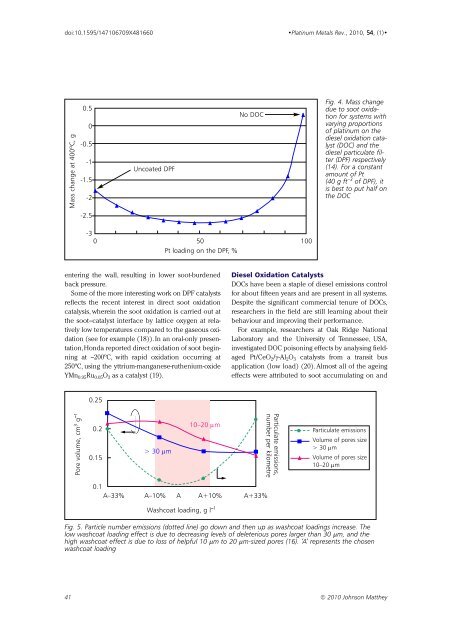Download Issue PDF - Platinum Metals Review
Download Issue PDF - Platinum Metals Review
Download Issue PDF - Platinum Metals Review
Create successful ePaper yourself
Turn your PDF publications into a flip-book with our unique Google optimized e-Paper software.
doi:10.1595/147106709X481660<br />
•<strong>Platinum</strong> <strong>Metals</strong> Rev., 2010, 54, (1)•<br />
Mass change at 400ºC, g<br />
0.5<br />
0<br />
-0.5<br />
-1<br />
-1.5<br />
-2<br />
Uncoated DPF<br />
No DOC<br />
Fig. 4. Mass change<br />
due to soot oxidation<br />
for systems with<br />
varying proportions<br />
of platinum on the<br />
diesel oxidation catalyst<br />
(DOC) and the<br />
diesel particulate filter<br />
(DPF) respectively<br />
(14). For a constant<br />
amount of Pt<br />
(40gft –3 of DPF), it<br />
is best to put half on<br />
the DOC<br />
-2.5<br />
-3<br />
0 50 100<br />
Pt loading on the DPF, %<br />
entering the wall, resulting in lower soot-burdened<br />
back pressure.<br />
Some of the more interesting work on DPF catalysts<br />
reflects the recent interest in direct soot oxidation<br />
catalysis, wherein the soot oxidation is carried out at<br />
the soot–catalyst interface by lattice oxygen at relatively<br />
low temperatures compared to the gaseous oxidation<br />
(see for example (18)). In an oral-only presentation,Honda<br />
reported direct oxidation of soot beginning<br />
at ~200ºC, with rapid oxidation occurring at<br />
250ºC, using the yttrium-manganese-ruthenium-oxide<br />
YMn 0.95 Ru 0.05 O 3 as a catalyst (19).<br />
Diesel Oxidation Catalysts<br />
DOCs have been a staple of diesel emissions control<br />
for about fifteen years and are present in all systems.<br />
Despite the significant commercial tenure of DOCs,<br />
researchers in the field are still learning about their<br />
behaviour and improving their performance.<br />
For example, researchers at Oak Ridge National<br />
Laboratory and the University of Tennessee, USA,<br />
investigated DOC poisoning effects by analysing fieldaged<br />
Pt/CeO 2 /γ-Al 2 O 3 catalysts from a transit bus<br />
application (low load) (20). Almost all of the ageing<br />
effects were attributed to soot accumulating on and<br />
0.25<br />
Pore volume, cm 3 g –1<br />
0.2<br />
0.15<br />
> 30 μm<br />
10–20 μm<br />
0.1<br />
A–33% A–10% A A+10% A+33%<br />
Particulate emissions,<br />
number per kilometre<br />
Particulate emissions<br />
Volume of pores size<br />
> 30 μm<br />
Volume of pores size<br />
10–20 μm<br />
Washcoat loading, g l –1<br />
Fig. 5. Particle number emissions (dotted line) go down and then up as washcoat loadings increase. The<br />
low washcoat loading effect is due to decreasing levels of deleterious pores larger than 30 μm, and the<br />
high washcoat effect is due to loss of helpful 10 μm to 20 μm-sized pores (16). ‘A’ represents the chosen<br />
washcoat loading<br />
41 © 2010 Johnson Matthey
















